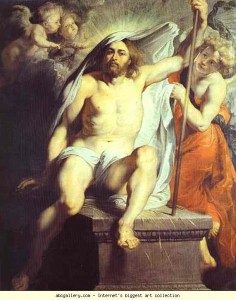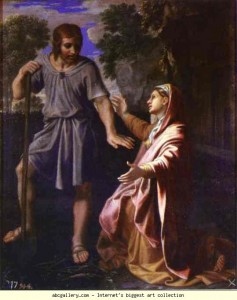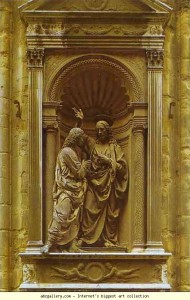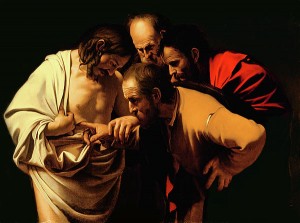To begin, we must be entirely clear on what the case for the resurrection is not. No one is arguing that some historically reliable documents report a resurrection, and that we should therefore believe that a resurrection occurred. Rather, the historical method is used to establish certain facts, and a miracle is inferred as the best explanation of those facts. Here we can focus on 18 facts:
1. Jesus was put to death by crucifixion. This was a shameful death which should have devastated the disciples and ended Jesus’ movement.
2. His body was buried in an identifiable tomb (Joseph of Arimethea’s).
3. A few days later a group of women followers claimed that Jesus’ tomb was empty.
4. It would have been more convenient for the Church if this discovery had been made by men (whose testimony was considered more reliable) and by one of the early heroes of the faith (like Stephen or Cleopas).
5. The disciples were not expecting Jesus to be resurrected. Jews had many other ways of conceiving life after death: the disciples could have claimed to have seen Jesus’ angel, or his Spirit in heaven, or that Jesus had been translated into a “star”. It was decidedly odd to claim he was resurrected from an identifiable tomb.
6. Multiple appearances took place in which many people who had known Jesus well believed they had seen him alive again.
7. Paul, who initially persecuted the early Christians, became a follower of Jesus as a result of believing he had seen the risen Jesus.
8. James, the brother of Jesus, who was not a follower of Jesus before the crucifixion became a follower afterwards. He also became a leader in the church in Jerusalem and was put to death for his faith.
9. The Christian movement started in Jerusalem, where Jesus had been crucified, shortly after the crucifixion.
10. The message of the early Christians focused on the death and resurrection of Jesus. “Resurrection” could only mean that Jesus’ body had been raised from the dead.
11. The early Christians met on the first day of the week, and not on the Jewish Sabbath. Something about the Sabbath was significant to the first Christians.
12. The early Christian church had a highly exalted view of Jesus.
13. The early Christians were willing to die for their faith.
14. There was no attempt to venerate Jesus’ tomb.
15. Jewish apologetic claimed that the disciples stole the body; so Jewish critics agreed that the tomb was identifiable and empty.
16. The early church grew in a Hellenistic context that would have been hostile to the idea of bodily resurrection. Gentile philosophers wanted to escape the confines of the body; they didn’t want to be trapped in their bodies forever!
17. It is unlikely that the later Church invented the story of the empty tomb.”Bodily resurrection” would mainly have impressed Palestinian Jews, and not later Hellenistic Christians (who struggled with the idea that they would have resurrection bodies too). So the preaching of a resurrection could only have started with the first Jewish Christians in Palestine.
18. It is highly unlikely that the disciples stole Jesus’s body to keep Jesus’ movement going. If they wanted to venerate Jesus’ memory athey could just have said that they had had visions of Jesus’ “spirit” or “angel”.
Some explanation of these facts is sought; and it seems that the only adequate explanation is that God raised Jesus from the dead.
Some sceptics, like the philosopher Michael Martin, make great play of the fact that the Gospels were written some thirty to fifty years after the events that they describe. Furthermore, the Gospels were not written by the primary witnesses themselves – Mary of Magdala, the other women at the tomb, Thomas, Clopas or Peter. If Christians argue that the apostles John and Matthew are responsible for the Gospels that bear their names, the sceptic merely points out that this is highly controversial. The argument is that the Gospels are secondary and not primary sources. Therefore, we should not count the evidence from the Gospels when considering the resurrection.
Historians, on this view, should just go through primary sources, stroke out what seems unreliable and what is left is history. This is ill-informed nonsense. The sceptic is advocating what Roger Collingwood called a “scissors and paste” approach to history; an approach that historians reject. Philosopher of history Mark Day makes this clear:
The key to critical history is not so much that one excludes testimony, as that one reasons from the evidence to produced statements about the past that are in addition to anything testified. The historian includes in their account passages which cannot be found in any source.[3]
Historian John Tosh explains what differentiates history from source criticism.
…the procedure is rather to amass as many pieces of evidence as possible from a wide range of sources – preferably from all the sources that have a bearing on the problem in hand. In this way inaccuracies and distortions of particular sources are more likely to be revealed, and the inferences drawn by the historian can be corroborated.[4]
If we were to follow the sceptic’s methodology, most of ancient history would find its way to the wastepaper basket.[5] Luke Pitcher points out ancient historians did not use modern scholarly apparatus like footnotes. We often do not know the exact source that an Ancient Historian like Arrian or Thucydides is using to reconstruct the past. Pitcher calls this the “action of the swan”.
Modern writers of history …usually let the reader see the processes by which their narrative of events progesses. Ancient historians often do not. Like a swan, the narrative of the work of ancient history glides ever forwards. But the processes which sustain its momentum remain submerged and invisible[6]
However, while we must read ancient history critically, Pitcher reminds us that ancient historians had access to good sources. Arrian, who wrote his history of Alexander the Great’s campaigns (The Anabasis) centuries after the great man’s death, relied on the works eyewitnesses like Aristobulus and Ptolemy. Tacitus could rely on sources like the Acta Senata when writing about events that occurred long before his birth. Perhaps the Gospels were written 30 years after the events that they describe. This misses the point. We need to ask if the Gospel writers accessed earlier material; and the presence of memorable oral traditions, anachronisms, embarrassing material, and a general verisimilitude suggests that they had.
As it happens, we do have the eyewitness testimony of at least one person – the Apostle Paul. When we read what Paul actually says we can see that his testimony provides important evidence for the resurrection. But, frankly, this skeptical demand for a note signed by an eyewitness is more than a little puzzling. Famously, we do not have an eyewitness account in which Hitler sets out to eliminate the Jews of Europe; yet only the very wicked, or very foolish, would suggest that this is evidence of Hitler’s innocence. We simply cannot explain the events of the Holocaust unless Hitler was its driving force. There are no eyewitnesses to Marilyn Monroe’s suicide; but this is not evidence that she was murdered!
Julius Caesar does not narrate his crossing of the Rubicon; he merely says that he “set out with his legions to Ariminum” suppressing his illegal crossing of the river.We do not have an eyewitness to Caesar’s decision to break the laws of Rome and to plunge the Roman Republic into civil war. We have no eyewitness account of the crossing; yet Appian, Plutarch and Suetonius attach great import to it. Given their access to accounts no longer available to us, it would be foolish to suggest that the event never occurred! We do not have an eyewitness account of Hannibal’s journey over the Alps, or the Roman defeat at Cannae. The list goes on and on.
 Though there is much more to the historian’s task, he asks “what occurred in the past so that our sources carried this particular testimony?” What caused the testimony that I have before me?” For example, it is unthinkable that the Romans would invent the story of their defeat at Cannae. So we will set Martin’s High School approach to history to one side, and search for a reasonable explanation of our 18 facts.
Though there is much more to the historian’s task, he asks “what occurred in the past so that our sources carried this particular testimony?” What caused the testimony that I have before me?” For example, it is unthinkable that the Romans would invent the story of their defeat at Cannae. So we will set Martin’s High School approach to history to one side, and search for a reasonable explanation of our 18 facts.
Biblical scholars like James Crossley and Bart Ehrman make what might be called the ‘I’m a historian objection’ to the resurrection. Neither Crossley nor Ehrman claim to be able to demonstrate that the resurrection definitely did not happen. Rather, they claim that from the perspective of the historian there are no good reasons to believe in the resurrection. Essentially, they are claiming that historiansas historians cannot seriously entertain the possibility that a miracle might have occurred. Ehrman claims that “it is not appropriate for a historian to presuppose a perspective or worldview that is not generally held”. The problem with miracles then is that they require theological beliefs and “since historians cannot assume these beliefs, they cannot demonstrate historically that such miracles happened.”
In terms of assessing the case for the resurrection, Crossley asks:
do we want to find whatever naturalistic causes are possible in historical explanation, leaving questions of the divine completely to one side, or do we want to take the pseudo-scientific route of Intelligent Design or Creationism and say that the supernatural can be shown to be directly intervening in historical change in the study of history?”
His clear suggestion, and Ehrman is in complete agreement, is that when it comes to history, we should indeed leave questions of the divine to one side. In other words, historical investigation requires what is calledmethodological naturalism, the idea that only naturalistic explanations should be considered. Even Christians or other religious believers should set aside their religious beliefs for the purposes of doing history. So if we are going to carry out a historical investigation of the evidence relating to the aftermath of Jesus’ death, we should rule out the resurrection since proper historical methodology precludes it. This doesn’t mean that the resurrection definitely didn’t happen, just that there can be no historical evidence for it.
 What should we make of this approach? Suppose that historical inquiry must also be restricted to purely natural explanations. Does that mean that there could be no evidence for the resurrection? Of course not. That question can’t be settled just by a definition. If historians wish to restrict themselves to natural explanations, that’s up to them, but it would be very poor reasoning indeed to think that merely adopting such a methodology rules out evidence for the resurrection. It would be like a fisherman who concludes that there are no fish in the lake below a certain size because he has never caught any, forgetting to take into account that the nets he has been using could not possibly catch fish below that size. So adopting this kind of approach wouldn’t mean there was no evidence for the resurrection; it would just mean that when we consider evidence for the resurrection we are no longer engaging in this naturalistically defined version of history.
What should we make of this approach? Suppose that historical inquiry must also be restricted to purely natural explanations. Does that mean that there could be no evidence for the resurrection? Of course not. That question can’t be settled just by a definition. If historians wish to restrict themselves to natural explanations, that’s up to them, but it would be very poor reasoning indeed to think that merely adopting such a methodology rules out evidence for the resurrection. It would be like a fisherman who concludes that there are no fish in the lake below a certain size because he has never caught any, forgetting to take into account that the nets he has been using could not possibly catch fish below that size. So adopting this kind of approach wouldn’t mean there was no evidence for the resurrection; it would just mean that when we consider evidence for the resurrection we are no longer engaging in this naturalistically defined version of history.
Ehrman and Crossley don’t simply rely on insisting that historians ignore the supernatural. Both attempt to offer naturalistic explanations which need to be addressed by those of us who wish to defend the resurrection. However, given the above discussion, there is clearly something fishy going on. It’s all well and good for them to put their naturalistic explanations on the table, but it’s hardly surprising when they conclude that these explanations are much better than supernatural explanations since they don’t allow supernatural explanations on the table at all. In fact, so much is Ehrman committed to this approach that he thinks that even a conspiracy theory such as the disciples having stolen the body or the apparent death theory – that “Jesus didn’t really die but went into a coma” – are more plausible than the resurrection. Why? It certainly isn’t because Ehrman thinks these explanations are plausible; he knows perfectly well that they aren’t. No-one thinks it’s even remotely plausible since, as David Strauss, who rejected the resurrection himself, put it a long time ago:
It is impossible that a being who had stolen half-dead out of the sepulchre, who crept about weak and ill, wanting medical treatment, who required bandaging, strengthening, and indulgence, and who still at last yielded to his sufferings, could have given the impression that he was a Conqueror over death and the grave, the Prince of Life, an impression which lay at the bottom of their future ministry.
No, the reason Ehrman thinks the apparent death theory preferable to the resurrection is simply because it is a natural explanation and so is at least permitted on the table of explanations. Crossley is more measured in his approach, but he seems to end up in a similar position when he claims, “If some this-worldly arguments explaining the empty tomb are necessarily speculative, how speculative are arguments that push instead for the supernatural?” It seems as if any natural explanation is to be preferred simply because it is not supernatural.
Ehrman does provide a justification for his anti-supernatural bias based on probability:
A resurrection would be a miracle and as such would defy all “probability.” Otherwise it wouldn’t be a miracle. To say that an event that defies probability is more probable than something that is simply improbable is to fly in the face of anything that involves probability.
This is a breath-taking mistake on Ehrman’s part since it involves a very basic mistake in probability theory. We’ll assume that by ‘defy all probability’ Ehrman doesn’t think that a miracle is completely impossible. In fact, I don’t need to assume that since Ehrman nowhere suggests that it is impossible.[He’s not even claiming the resurrection didn’t happen, just that “historical sciences are of no help in establishing exactly what happened”. So it seems all he can mean by ‘defies all probability’ is something like ‘extremely improbable’.
Still, how can something ‘extremely improbable’ be more probable than something that is simply improbable? Does that fly in the face of probability reasoning? No. Ehrman has simply failed to distinguish between the prior and posterior probabilities. The former is the probability before we take the evidence into account and the posterior after we take it into account. And something might be extremely improbable before the evidence is taken into account and yet extremely probable afterwards. For example, it is extremely improbable that your friend will win the lottery in a given week- but it wouldn’t require too much evidence to make it seem extremely probable that they had won the lottery.
So we can agree with Ehrman that the resurrection might be extremely improbable to begin with, but why would he think that it must always remain so and that the evidence could not, even in principle it seems, change this? He might object that there’s a difference between the resurrection and the lottery example because the latter is a natural event. But in that case, it isn’t probability theory doing the work, it’s simply Ehrman’s anti-supernatural bias.
In short, whatever the merits of Ehrman’s and Crossley’s attempts to explain away evidence for the resurrection, their ‘I’m an historian objection’ fails miserably. If it is simply based on the idea that historians can only countenance purely natural explanations, then it is very weak indeed because, first of all, it basically tries to settle the issue by a definition of ‘history’ and, secondly, even if we grant this, there’s no reason why we can’t go beyond this naturalistically defined version of history to consider the evidence without such a restriction. To think otherwise is just to adopt an anti-supernatural bias. Alternatively, if take on board Ehrman’s attempted justification of ruling out supernatural explanations, we have seen that it is no help at all since it is based on a misunderstanding of probability theory and just boils down to an anti-supernatural bias in any case.
———————————————————————————————————————————————————————————————-
[1] Different scholars have defended the historicity of the Gospels in different ways. The approach here is based on David Glass’s in chapter 10 of Atheisms New Clothes.
[2] As if the discovery of a 1st Century document in Palestine, saying “I, James, witnessed the Resurrected Christ” would somehow improve the case for the Resurrection! This wouldn’t even tell us something we didn’t already know – that James believed that he had witnessed the Resurrected Christ.
[3] Philosophy of History (Continuum:2008),18
[4] The Pursuit of History (Longman:2010),134. In any case documents written 30 years after events can be described a Primary sources (ibid,92).
[5] Although we should note that a good case can be made for the presence of eyewitness material in the Gospels. See Richard Bauckham’s online essay “The Authenticity of Apostolic Eyewitness in the New Testament”; and his more detailed argument in Jesus and the Eyewitnesses: the Gospels as Eyewitness Testimony (Eerdmans:2008)
[6] .Writing Ancient History (I.B.Tauris:2009)p6


